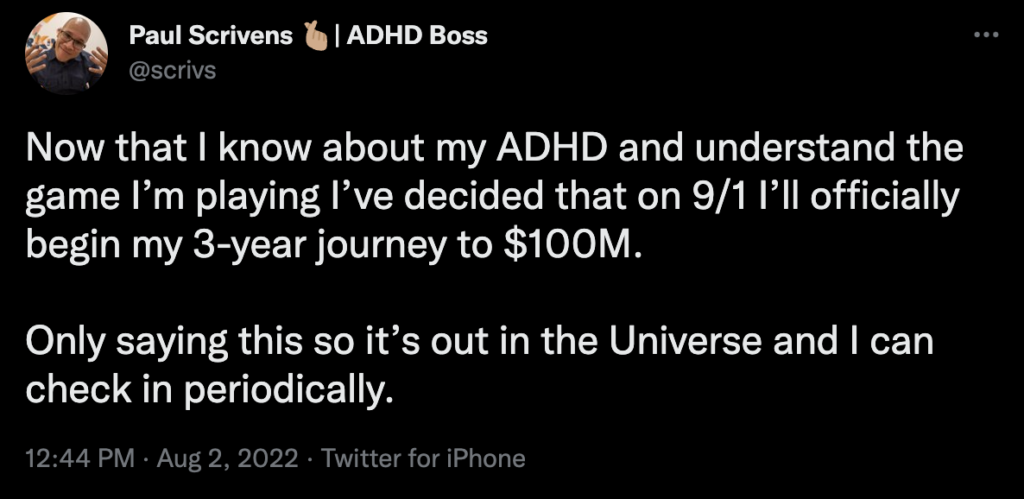
The idea of making $100M is pretty appealing.
Trying to figure out how to do it and then execute on that is less appealing.
But I’m going to make it happen and I’m going to show you how.
Now, it’s important to realize that 3 years might not seem like a long time, but in the Internet space, 3 years is an eternity. That’s over 1,000 days.
LOADS of time.
But can you really plan out how to make $100M?
I think you can do a pretty rough outline of things and then over time that outline becomes a lot more clear.
The Formula Is Simple
Something that I’ve always taught my students is the Pocket Business Formula. It’s nothing fancy.
Audience x Offer = MoneyIt’s the equation for every single business out there.
You need an audience and an offer to make any type of money.
That sounds great when trying to make your first $1 online, but not when trying to make $100M.
But you gotta stick with me here because the further you get away from the basics, the more difficult you make your life.
How I’ve been making the majority of my money over the past couple of years is through selling online courses and other digital products.
While you can scale these to 7 and 8-figures, $100M gets REALLY hard unless you’re trying to pull a fast one on people.
And that’s not what this is about (or ever about).
I Need to Scale
So then you’re looking at software because software can allow for recurring revenue and scale a lot quicker.
But starting off with software isn’t the right play and I’ll tell you why.
I don’t have an audience.
Remember the formula above?
Of course, you might be saying that I simply need to work on the software WHILE building an audience, but I think that’s the slow route.
I think it’s much faster if you build an audience and then leverage that audience to help the software grow quicker.
But there’s another catch that I think most builders miss and that is solving the problem before you code a single thing.
First You Teach the Solution and Then You Automate It.
It takes much less time to get a piece of content out the door than it does some software.
Minimum viable products (MVPs) are great, but there is still a chance you’re building something that takes time and effort to test in a market that doesn’t want it.
A quicker route is to put out a piece of content showing people how to solve their problems. If people respond well to it, then you might have something.
Software is essentially a developer saying, “You could do it the slow way or you could do it the fast way using this tool.“
The reason developers struggle is that they don’t always find a problem that is important enough for people not to fix manually.
The people that will pay for the software are also the ones that are willing to pay for the content to help them solve the problem.
By taking a teach-first approach, I can throw out a lot of ideas over the next year to see what really gains traction.
But now we run into the same problem again.
I don’t have an audience.
Be Prolific
It’s pretty simple.
In today’s world, success is bound by a simple rule: It’s not who you know, but who knows you.
When you get the right people to know you exist then more opportunities appear.
Just a few people usually accelerate any viral growth. But they have to be the right people.
This means I need to get the right people to know me. I don’t know who those people are and I don’t need to figure that out yet.
I just need to be prolific with content and be in as many places as possible with the right type of content.
Every piece of content that I’m able to publish is another form of an idea being tested.
This will be the focus for the first year.
Get as much high-quality content out there and become known by as many people as possible.
Years 2 & 3 are when the software becomes involved.
One Brand Is Limiting
The problem with trying to be prolific starting from 0 is that you can’t flood just one brand.
For example, I can’t post 50 tweets (not replies, tweets) a day from my own account without flooding people’s timelines and them getting sick of me.
I’d have to count on the algorithm to throttle me.
Plus, it gets hard to test across multiple audiences from the same brand without hindering its growth.
It’s easier to grow an account when people know the account is speaking to them.
So with all of that in mind, I have two buckets of brands.
Bucket 1: Solopreneurs
Bucket 2: Consumer
What in the fuck? 4 different brands?
That’s pretty idiotic, right?
Kind of. Maybe. Probably.
But I have a plan.
Not Every Line Catches a Fish
Again, to grow a business successfully you need to know who you’re talking to so you can speak their language.
You need to meet them in the conversation they are having in their head.
Each piece of content published isn’t meant to set records. If a piece takes off then that’s a bonus.
But each piece of content does need to serve the purpose of talking to the right person when they are paying attention.
And each brand within a bucket builds off of the other.
It will be a lot easier to see in action, but when you know how to create Infinite Content, you realize that content isn’t the bottleneck.
I have to distill 20 years of knowledge and wisdom into 1000s of different pieces of content within year 1.
This is me casting out as many lines as possible to see how many fish I can catch.
What if a brand takes off do I lean heavily into it?
It depends on why it takes off and if I see an avenue to create software with that audience.
The goal at the end of Year 1 is to have an audience of 1,000,000 people.
Now to be honest it doesn’t matter if I hit that number or not. What matters is that I do have a decent size audience to allow more opportunities to open up.
